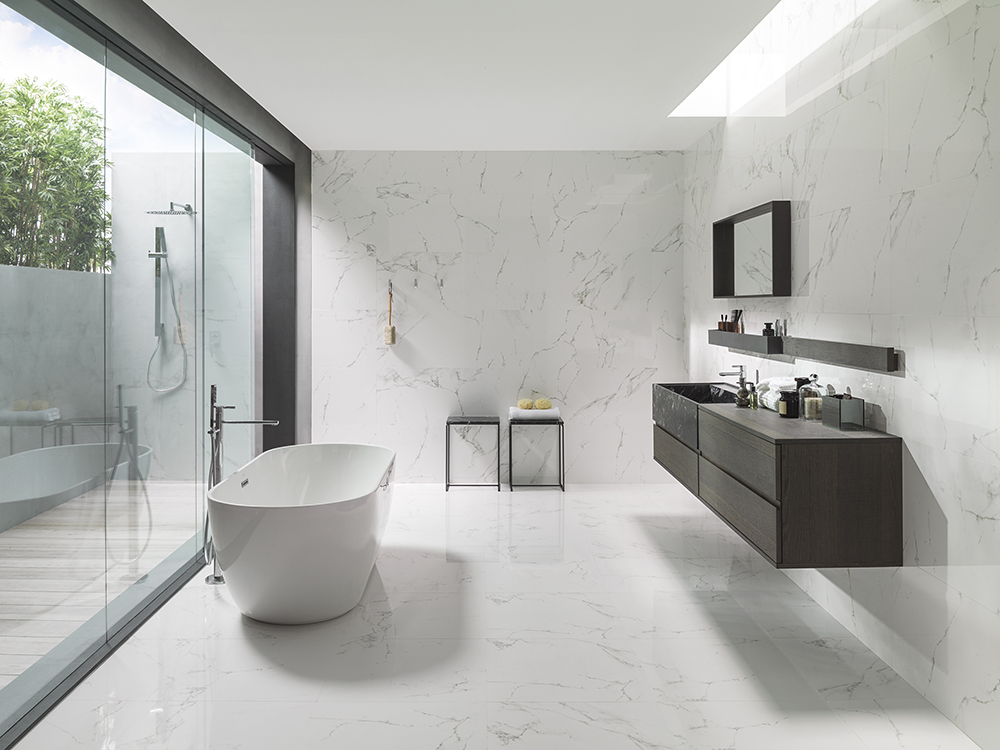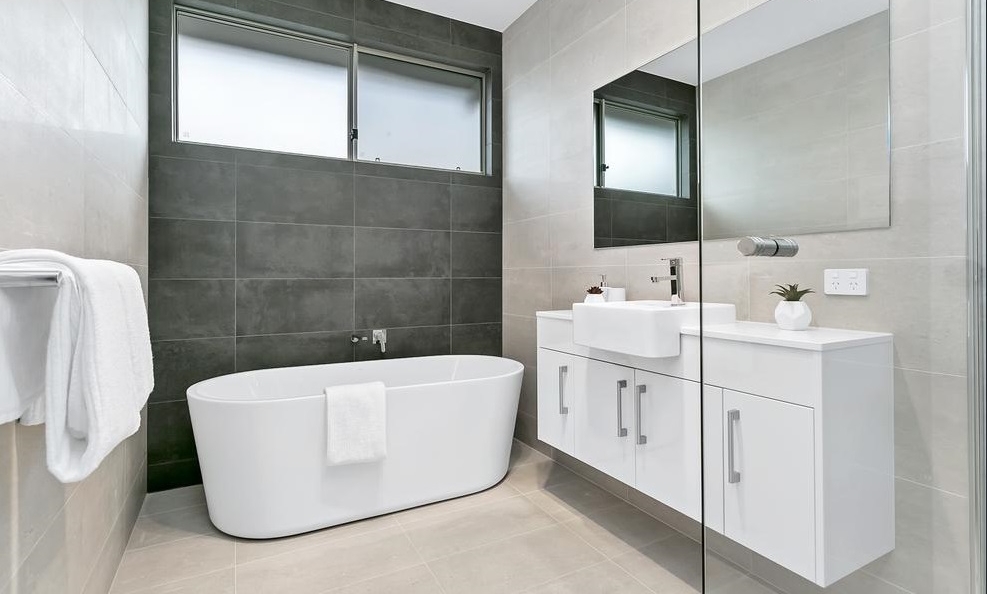Everything You Need to Know About Choosing Bathroom Tiles
When it comes to choosing bathroom tiles, deciding on the look and feel you wish to portray is dictated solely by the tiles you select. The bathroom is one of the most important spaces of the home, and the most frequently by families and guest. It may seem like an overwhelming experience with the endless choice of colours, sizes, styles, shapes, finishes and materials to choose from. With our extended experience and knowledge in the tile and stone industry, we guide you on everything you need to know about choosing bathroom tiles.
Tip No. 1: DO YOUR HOMEWORK
When it comes to choosing bathroom tiles, it important to understand the different types of materials and what they are most suited for. Here are the most common types of tiles used in bathrooms:
Ceramic tiles:
Ceramic or non-porcelain tiles is the perfect tile surface for kitchens, bathrooms, basements, porches, laundries, powder rooms, and other moisture-prone areas. Ceramic tiles are commonly made with red, brown or white clay that is fired in a kiln and finished with a durable glaze which carries the colour and pattern on the surface of the tile. The glazed surface of the tile makes the tile dense and non-porous which gives the characteristic of stain, fire and slip resistant. Ceramic floor tiles are suitable for bathrooms that have a light to moderate traffic, and can be relatively prone to wear and chipping. Ceramic tiles have a generally high water absorption rate making the surface impervious to water penetration and stains. Ceramic tiles today, come in a matt, satin, gloss and polish finish, giving you endless options for the walls and floors of your bathroom. Ceramic tiles are very easy to clean and maintain. When well cared for, ceramic floor tiles are one of the longest lasting products on the market today.
Porcelain tiles:
Porcelain tiles offer strong advantages when it comes to design, its strong nature allows endless ideas for interior and exterior applications. The full body porcelain tile carries colour and pattern through the entire thickness of the tile making them a much harder and denser tile. Porcelain tiles are suitable for any wall or floor application in commercial to the highest traffic areas of the home. Porcelain floor tiles are great for bathrooms in terms of wear and tear in high traffic areas from families to pets. Porcelain floor tiles are a hard wearing surface that is resistant to stains, scratches and easy to clean and maintain.
Stone tiles:
If you’re going for a more natural earthy feel, there is a wealth of options when it comes to natural stone tiles. Natural stone tiles come in an array of colours and styles; most commonly used are marble, limestone, travertine, slate and granite. It is important to note, that natural stone tiles are porous, which means they are prone to absorbing water, lubricants and stains that are left for long periods of time. Sealing your tile after being laid and periodical maintenance i.e. sealing will keep your stone looking flawless and prevent any stains or damages to the surface. A seal helps to create a barrier between water and the stone to prevent liquids absorbing into the surface and ensure longevity. The earth itself is one of the best manufacturers for materials, so you are guaranteed to have a hard wearing surface that is also aesthetically pleasing. The beauty of natural stone’s unique pattern varies from tile to tile, so keep in mind that no two natural stone tile surfaces will be the same. It is important to steer clear from bleaches or any harsh chemicals on natural stone as they are inclined to eat into the surface.
Featuring our Silver Travertine Light Crosscut By Brillaint SA
Mosaic tiles:
Mosaic tiles are great for creating a unique feature in any bathroom design. The endless options in colour, style and size will leave you truly mesmerised. There is no denying how great a mosaic floor tile looks but can tend to be quite slippery when wet. When choosing mosaic tiles for your bathroom floor be sure to check the slip rating standards and the warranty. Glass mosaic tiles are relatively easy to clean but remember the more grout lines you have, the more cleaning is involved!








Tip No. 2: Slip Wear Ratings
It can be overwhelming choosing from a range of options when it comes to tiles for wet areas. Colours, sizes and finishes are endless! But the key is to choose a tile that has a high slip rating. Tiles are put through a slip rating test that assesses the frictional characteristic of the surface to detect what is best suited for different environmental conditions. The test measures the long-term wear throughout the life of a floor, taking into consideration, the installation process, wear characteristics, cleaning maintenance and anticipated traffic. See the below table to guide you when choosing tiles for residential or commercial application.
PEI Class 1 Rating (No foot traffic)– Recommended for wall use only in residential and commercial applications.
PEI Class 2 Rating (Light traffic)– Recommended for both wall use and bathroom floor applications.
PEI Class 3 Rating (Light to moderate traffic)– Recommended for countertops, walls, and floors where normal foot traffic is expected.
PEI Class 4 Rating (Moderate to heavy traffic)– Recommended for all residential applications as well as medium commercial and light institutional.
PEI Class 5 Rating (Heavy to extra heavy traffic)– Recommended for all residential as well as heavy commercial and institutional applications. Most porcelain tiles have a PEI rating of 5, which makes them the hardest wearing tiles on the market.
Tip No. 3: Choosing the size of your tile
Rule of thumb when designing a bathroom is to consider the size of the room first. Large format tiles look stunning on both walls and floors to give a large bathroom a flawless finish. However, for smaller bathroom settings we suggest giving your bathroom a feature such as penny rounds or mosaic tiles. If you are space limited, an oversized diamond pattern on a bathroom floor can create diagonal lines that give the eye a longer path to follow from one side of the room to the other, so the room feels bigger than it really is. It might seem contradictory, but choosing larger tiles for a small bathroom works because you have less grouted joints which give the illusion of more space.
Large format tiles are great for emphasizing the size of a bathroom to look elongated. At Italia Ceramics tile showroom Adelaide, we stock a wide variety of floor tiles in multiple sizes, to ensure the right size, colour and finish works in your bathroom. But it doesn’t stop there. When choosing shower tiles you need to take into consideration the type of drains that will be installed in your bathroom. If you choose big tiles in a bathroom with limited space, you will find more grout lines are required in showers and tend to look untidy and messy. If you are using strip drains in your shower, you will find any tile, big or small, irregular, square, or rectangle, even large format tiles will work well together cooperatively and you can hold on to your stylish ambitions! Strip drains are a popular choice for being discrete and require minimal grout tiles – means less grout cleaning. We recommend you speak to your tiler before setting your heart on a tile that may not be suitable for your bathroom.
Tip No. 4: The Rules of Colour
One of the most exciting parts in choosing tiles is picking a colour that suits your style and personality. But as a rule of thumb, colour plays an important role in projecting a warm and inviting ambience or a cool and tranquil retreat.
Dark colours not only add warmth and hide the trails of dirt in the bathroom, but they can tend to make a space feel enclosed. So it’s important to go easy on darker colours. Consider adding a gloss wall tile to enhance and create an illusion of space. A glossy tile has a reflective character and tends to look brighter and lighter when paired with darker colour schemes.
Neutral colour tones are great for keeping the design simple and basic, allowing your accessories be the staple piece to your bathroom. Lighter neutral colours are great in small bathrooms for making a tight space more spacious and open.
When searching tiles for your bathroom they can tend to all look the same, but it’s important a slight difference in the shade can impact the overall look (or even a disastrous match!) Our experienced interior design consultants will provide you will expert technical advice to ensure you receive the perfect outcome for your bathroom.
Tip No. 5: Take home a tile sample before you buy
One thing we can not stress enough is to take home a tile sample. Even when you think you are 100% set on a tile it is always a good idea to take the selected tile of choice to your home to see what the colour, size and finish of the tile will look like. The colour of the tile can look completely different depending on the type of lights the area will be exposed to, whether its natural light, downlights or fluorescent lights. The tricky part is light is never consistent and can also be contingent on the time of day and the environment. At Italia Ceramics, our staff highly recommend our customers to take home samples to see what they look like in their home.
Tip No. 6: Measure and remeasure everything
There’s nothing worse when you have chosen all your tiles for your home and then when it comes to laying the tile it’s not the right size! When renovating your home consider the shape and layout of the room and how the space fits accordingly with the rest of the home.
The general rule of thumb when laying a 300×600 floor tile is stand in the doorway of the bathroom and have the back wall laid horizontal. It is recommended to lay the 600mm edge horizontal so it lines up with your floor tile. However, every bathroom is different in size and layout.
Project by Creative Structures featuring our Monton Silver and ZI6919B6 (Feature wall)
Laying wall tiles vertically
If your bathroom is small and narrow with low ceilings, we recommend laying your tile vertically to subtly emphasize the height of the space. Opt for 300×600 tiles or larger tiles instead of small features tiles – the more grout lines you can visually see can make the space feel confined and cluttered.
Laying wall tiles horizontally
If your bathroom has limited floor space with tall ceilings, laying your bathroom floor tile horizontally will create the illusion of width making the space feel more open. Any rectangular tile will accentuate the space because your eyes are drawn to the horizontal lines making space appear wider and longer that it really is!
The continuity of running a horizontal floor tile on the walls will make a wrapping effect. If you use the same tile on the walls and floors of your bathroom this will emphasize the illusion of the space looking wider and open.
If you are building and have chosen Italia Ceramics as your preferred supplier for your tiles, our experienced interior designers will take you through the process, making sure your tile choice is one you will love and happily live with.





















